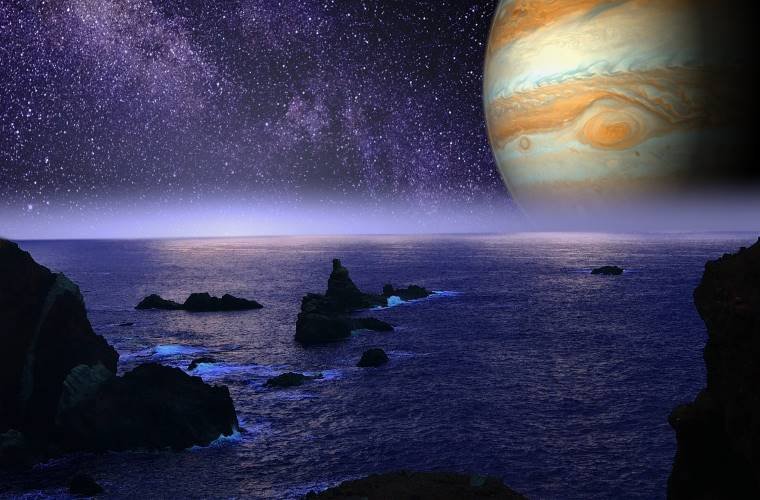NASA’s hunt for extraterrestrial life has a new target, Jupiter’s icy moon Europa. According to researchers involved, a new, dedicated mission will peer miles below Europa’s icy surface to determine if the sea of water hidden underneath is capable of supporting life as we know it. This same mission will also hunt for water plumes like those found on Saturn’s moon Enceladus, which could provide future missions a means for collecting potentially life-containing samples.
BACKGROUND: ICY MOONS AND WATERY PLUMES
In 2005, NASA released the first images of Saturn’s moon Enceladus, including its now famous water plume that sprays a continuous stream of water vapor miles above the moon’s surface. Basically the size of Texas, this icy moon is covered with a frozen ice shell, but has liquid water underneath. Due to pressures from gravity and other forces, this water is continually released into space, creating the telltale plume.
According to the press release announcing this latest mission, “the plume also thrust Enceladus and other worlds in the outer solar system, with no atmospheres and far from the heat of the Sun, toward the top of NASA’s list of places to search for signs of life.”
This includes Europa, which is similar to Enceladus, in that it has an icy surface and liquid water underneath. But that is where most comparison’s stop.
For instance, Europa is much larger, almost the same size as Earth’s moon, and therefore likely experiences plate-tectonics. Biologists on Earth believe that plate-tectonics contribute to the flow of nutrients and other life sustaining minerals throughout the biosphere, and astrobiologists believe this same mechanism may be at work on Europa.


ANALYSIS: EUROPA CLIPPER ON THE HUNT FOR HABITABILITY
“Scheduled to launch in 2024, NASA’s Europa Clipper spacecraft will study the moon from its deep interior to its surface to determine whether it has ingredients that make it a viable home for life,” reads the press release.
Presently, researchers believe Europa has a much deeper saltwater ocean than Enceladus, maybe even 40 to 100 miles deep. This number alone would mean that the icy moon contains twice as much sea water as Earth’s oceans. And given the extra heat generated by its proximity to Jupiter, this also means there is a distinct possibility that the floor of this ocean contains hydrothermal vents. On Earth numerous lifeforms thrive around such vents without the need for sunlight.
Scheduled to arrive in Europa’s orbit in 2031, the mission is not specifically designed to hunt for life. However, if it does find a habitable environment, as well as evidence of icy plumes similar to those found on Enceladus, it will no doubt make for a tempting target for future missions searching for signs of microbial life inside those plumes.
“It all comes down to whether Europa is habitable,” said Shawn Brooks from NASA’s Jet Propulsion Laboratory in Southern California, and who is a member of Europa Clipper’s Europa Ultraviolet Spectrograph (Europa-UVS) science team, “and that comes down to having some understanding of what is happening below the surface, which we can’t reach yet,”
OUTLOOK: IN 2031 THE HUNT BEGINS
In the end, the team assigned to the Europa Clipper mission knows they are looking for plumes that may not even exist, but they also know from experience to be prepared for what they don’t plan to find.
“I do suspect Europa is active and letting some material escape,” said Matthew McKay Hedman, a member of Europa Clipper’s Mapping Imaging Spectrometer for Europa (MISE) science team and associate professor in the Department of Physics at the University of Idaho. “But I expect that when we actually get to understand how it’s doing that, it’s not going to be what anyone expected.”
“A lot of people think Europa is going to be Enceladus 2.0, with plumes constantly spraying from the surface,” added Lynnae Quick from NASA’s Goddard Space Flight Center, and a member of the science team behind Clipper’s Europa Imaging System (EIS) cameras. “But we can’t look at it that way; Europa is a totally different beast.”
Follow and connect with author Christopher Plain on Twitter: @plain_fiction

